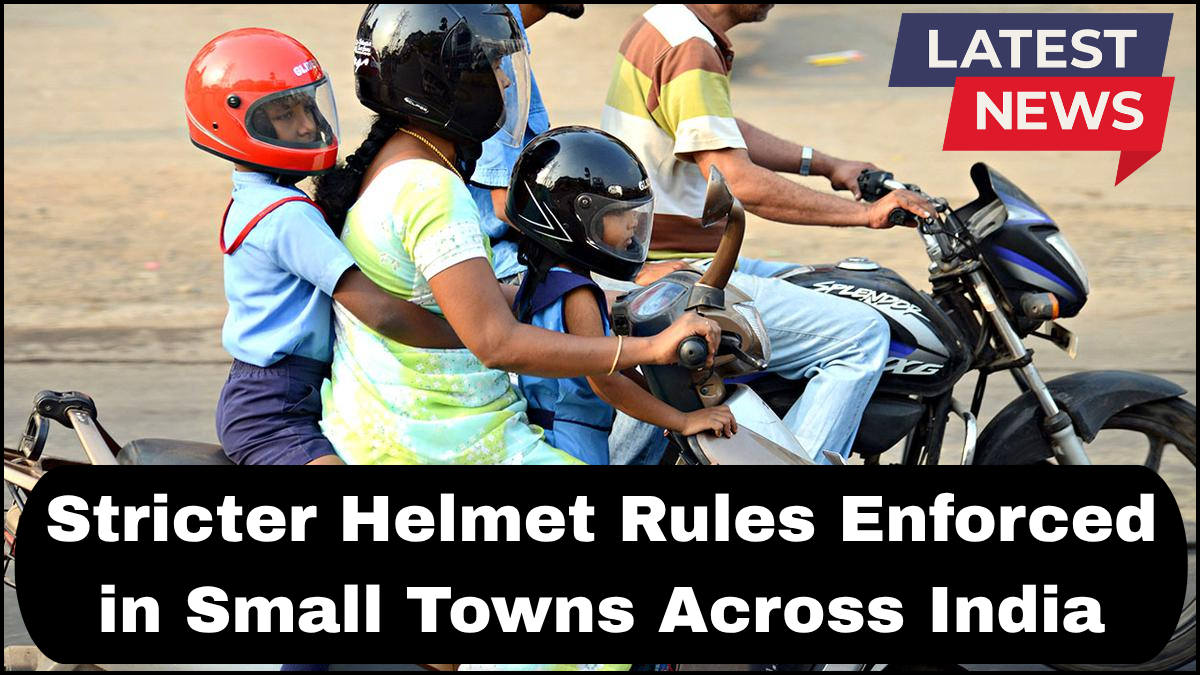In a decisive move to curb road fatalities and promote responsible riding habits, authorities across India have begun enforcing stricter helmet laws in small towns. While metropolitan cities have seen relatively higher awareness and compliance with helmet regulations, rural and semi-urban areas have lagged behind—until now.

A Shift in Focus: From Cities to Small Towns
Historically, helmet checks and penalties were more common in tier-1 cities, with traffic police focusing on urban congestion and highway violations. However, recent statistics revealed a disturbing trend: a significant percentage of two-wheeler deaths occur in small towns and semi-urban regions. In response, the government has extended its road safety efforts to these areas, ensuring road safety compliance in India is no longer a metro-centric policy.
The Ministry of Road Transport and Highways (MoRTH), along with state governments, has directed local police and transport departments to implement helmet regulations uniformly across the country, irrespective of town size or population density.
Why Helmet Laws Matter in Smaller Towns
Two-wheelers are the dominant mode of transport in small towns. Affordability and convenience make them the go-to option for daily commuting. However, low helmet usage—often due to ignorance, cultural attitudes, or lack of enforcement—has contributed to higher fatality rates.
Stricter helmet laws in small towns aim to tackle this directly. Riders and pillion passengers are now legally required to wear Bureau of Indian Standards (BIS)-certified helmets. Failure to comply can result in fines ranging from ₹500 to ₹2,000, license suspension, and in some cases, seizure of the vehicle.
This stricter regime is being supported by awareness drives, community engagement, and even collaborations with schools and local influencers to spread the message.
Measures Being Implemented on the Ground
-
Increased Police Vigilance
Traffic personnel are now posted at key intersections, market areas, and school zones in towns previously considered “low-priority.” Regular checks are conducted, and spot fines are issued for non-compliance. -
Integration with Digital Traffic Systems
States like Maharashtra and Karnataka are integrating helmet violations into e-challan systems. Even small towns now see digital tickets being issued, which are harder to evade. -
Helmet Subsidy Schemes
Recognizing economic barriers, some district administrations are rolling out low-cost or subsidized helmet schemes, particularly targeting students and daily wage earners. -
Public Campaigns and Behavioral Nudges
Posters, local radio broadcasts, and public service announcements have been launched to change the public mindset. Campaigns use real-life accident survivors to tell their stories, making the consequences of neglect visceral and personal.
Resistance and Roadblocks
Despite the push, enforcement is not without challenges. Many still see helmets as a city-centric requirement, with some citing discomfort or inconvenience as reasons to avoid them. Enforcement officers in smaller towns also often face local pushback or political pressure to “go easy” on offenders.
However, governments are responding with consistency and clarity. Emphasizing that road safety compliance in India is a universal goal—not a luxury or urban privilege—helps shift public perception.
Long-Term Impact
The ultimate goal is to normalize helmet use across all regions, regardless of social or economic status. With stricter helmet laws in small towns, India is moving toward a future where safer roads are not just a promise but a practice.
Beyond immediate penalties, the larger impact will be cultural. When small-town youth grow up wearing helmets by default, the next generation of riders will treat road safety as second nature, not an imposed burden.
FAQs
Q1. Why are helmet laws being enforced more strictly in small towns now?
A1. Because data showed a high number of two-wheeler fatalities in these areas, indicating low compliance. The government is now prioritizing these regions to improve road safety compliance in India.
Q2. Do these laws apply to pillion riders too?
A2. Yes. Both riders and pillion passengers must wear BIS-certified helmets, regardless of age or gender.
Q3. What happens if someone is caught without a helmet in a small town?
A3. They may be fined between ₹500 and ₹2,000, and repeated violations can lead to license suspension or vehicle seizure.
Q4. Are there any subsidies or schemes for those who can’t afford helmets?
A4. Yes. Some state and district administrations are offering affordable or subsidized helmets, especially for students and low-income groups.
Q5. Is there any difference between the laws in cities and small towns?
A5. No. The laws are the same across India, but enforcement levels may have varied in the past. Now, efforts are being made to standardize enforcement regardless of location.
click here to learn more
